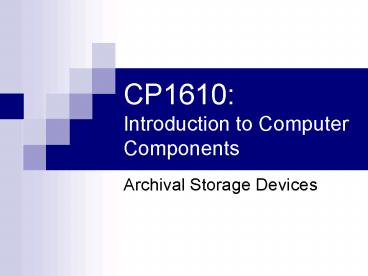CP1610: Introduction to Computer Components - PowerPoint PPT Presentation
Title:
CP1610: Introduction to Computer Components
Description:
CP1610: Introduction to Computer Components Archival Storage Devices What is Archival Storage? Similar to secondary storage. Typically more durable. – PowerPoint PPT presentation
Number of Views:87
Avg rating:3.0/5.0
Title: CP1610: Introduction to Computer Components
1
CP1610Introduction to Computer Components
- Archival Storage Devices
2
What is Archival Storage?
- Similar to secondary storage.
- Typically more durable.
- Used for long-term or permanent storage
- Data backups from hard disks
- Permanent storage of data that will not be
changed (ex music or movies)
3
Common Archival Storage Media
- Optical Storage
- Flash Memory
- Magnetic Storage
4
Optical Storage
- Use light (lasers) to read and write data.
- Not subject to data loss or corruption.
- Compact Discs (CDs)
- Digital Video Disks (DVDs)
5
How Optical Storage Works
- Light is used to burn a series of pits (dark
spots) on a disk. - Dark spots and light spots are read as 0s and
1s (binary). - Re-writable discs use Phase technology
- Special dyes are used that react to the laser
- The Phase of the dyes can be changed to change
the data.
6
Data Storage on Optical Media
- CD-ROM drives
- Use CDFS (Compact Disc File System) or UDF
(Universal Disk Format) - Hold about 780 MB of data.
- DVD drives
- Use only UDF
- Uses the MPEG-2 encoding standard
- Standard hold about 4.5 GB of data.
- Dual-layered DVDs can hold up to 8.5 GB of data.
7
- Optical discs have tracks and sectors, just like
magnetic disks. - Tracks and sectors are arranged in a spiral,
instead of concentric circles.
Floppy Disk
8
Flash Memory
- Also called solid-state storage.
- No moving parts (Data on the media is altered
using electrical signals). - Relatively high memory capacity.
- Commonly used for
- USB drives
- MP3 players
- Digital camera memory
- Mobile phone and PDA memory
9
Multimedia Compression Standards
- MPEG-1 standard
- Image compression for business/home applications
- MPEG-2 standard
- Video film compression on DVD-ROM
- MPEG-3 standard
- Audio compression
- MPEG-4 standard
- Video transmissions over the Internet
10
Magnetic Storage
- Like a cross between a floppy or hard disk, and
an audio cassette. - Stores data by aligning magnetic particles on a
tape. - Magnetic particles are read as 0s or 1s
(binary).
11
Advantages of Magnetic Storage
- Advantages
- Inexpensive and convenient
- Large capacity
- Several types and formats
- Disadvantage
- Sequential access
12
Other Archival Storage Media
- ZIP Disks (By Iomega) and SuperDisks (by
Imation). - Similar to 3.5 inch floppy disks, but bigger,
with more capacity. - Never became popular because of CDs and DVDs































